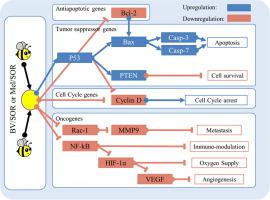Bioorganic Chemistry ( IF 4.5 ) Pub Date : 2021-09-03 , DOI: 10.1016/j.bioorg.2021.105329 Ghada H Mansour 1 , Mohammed A El-Magd 2 , Dalia H Mahfouz 1 , Ismail A Abdelhamid 3 , Magda F Mohamed 4 , Nada S Ibrahim 5 , Abdel Hady A Abdel Wahab 6 , Emad M Elzayat 7

|
There are current attempts to find a safe substitute or adjuvant for Sorafenib (Sorf), the standard treatment for advanced hepatocellular carcinoma (HCC), as it triggers very harsh side effects and drug-resistance. The therapeutic properties of Bee Venom (BV) and its active component, Melittin (Mel), make them suitable candidates as potential anti-cancer agents per-se or as adjuvants for cancer chemotherapy. Hence, this study aimed to evaluate the combining effect of BV and Mel with Sorf on HepG2 cells and to investigate their molecular mechanisms of action. Docking between Mel and different tumor-markers was performed. The cytotoxicity of BV, Mel and Sorf on HepG2 and THLE-2 cells was conducted. Combinations of BV/Sorf and Mel/Sorf were performed in non-constant ratios on HepG2. Expression of major cancer-related genes and oxidative stress status was evaluated and the cell cycle was analyzed. The computational analysis showed that Mel can bind to and inhibit XIAP, Bcl2, MDM2, CDK2 and MMP12. Single treatments of BV, Mel and Sorf on HepG2 showed lower IC50 than on THLE-2. All combinations revealed a synergistic effect at a combination index (CI) < 1. Significant upregulation (p < 0.05) of p53, Bax, Cas3, Cas7 and PTEN and significant downregulation (p < 0.05) of Bcl-2, Cyclin-D1, Rac1, Nf-κB, HIF-1a, VEGF and MMP9 were observed. The oxidative stress markers including MDA, SOD, CAT and GPx showed insignificant changes, while the cell cycle was arrested at G2/M phase. In conclusion, BV and Mel have a synergistic anticancer effect with Sorf on HepG2 that may represent a new enhancing strategy for HCC treatment.
中文翻译:

蜂毒及其活性成分蜂毒肽协同增强索拉非尼对 HepG2 细胞的抗癌作用
目前正在尝试寻找索拉非尼 (Sorf) 的安全替代品或佐剂,索拉非尼是晚期肝细胞癌 (HCC) 的标准治疗方法,因为它会引发非常严重的副作用和耐药性。蜂毒 (BV) 及其活性成分蜂毒肽 (Mel) 的治疗特性使其成为潜在的抗癌剂本身或癌症化疗的佐剂的合适候选者。因此,本研究旨在评估 BV 和 Mel 与 Sorf 对 HepG2 细胞的联合作用并研究它们的分子作用机制。进行了 Mel 和不同肿瘤标志物之间的对接。进行了 BV、Mel 和 Sorf 对 HepG2 和 THLE-2 细胞的细胞毒性。BV/Sorf 和 Mel/Sorf 的组合在 HepG2 上以非恒定比率进行。评估主要癌症相关基因的表达和氧化应激状态并分析细胞周期。计算分析表明,Mel 可以结合并抑制 XIAP、Bcl2、MDM2、CDK2 和 MMP12。BV、Mel 和 Sorf 对 HepG2 的单一处理显示较低的 IC50 比在 THLE-2 上。所有组合在组合指数 (CI) < 1 时均显示出协同效应。p53、Bax、Cas3、Cas7和PTEN 的显着上调 (p < 0.05)和Bcl-2、Cyclin-D1、观察到Rac1、Nf-κB、HIF-1a、VEGF和MMP9。MDA、SOD、CAT、GPx等氧化应激标志物变化不显着,细胞周期停滞在G2/M期。总之,BV 和 Mel 与 Sorf 对 HepG2 具有协同抗癌作用,这可能代表了一种新的 HCC 治疗增强策略。











































 京公网安备 11010802027423号
京公网安备 11010802027423号